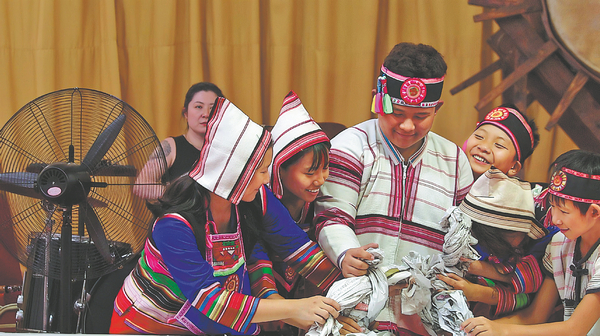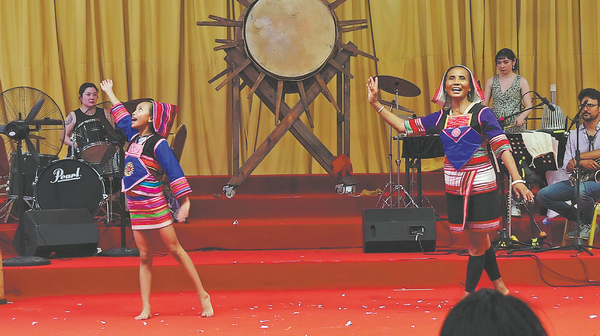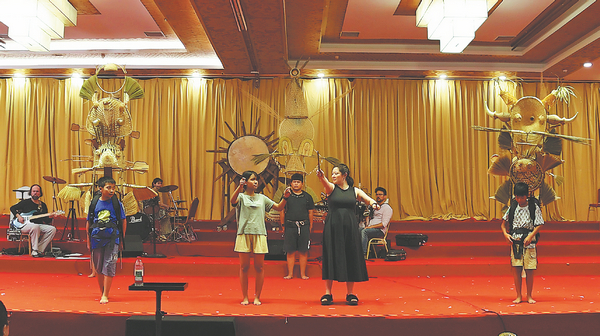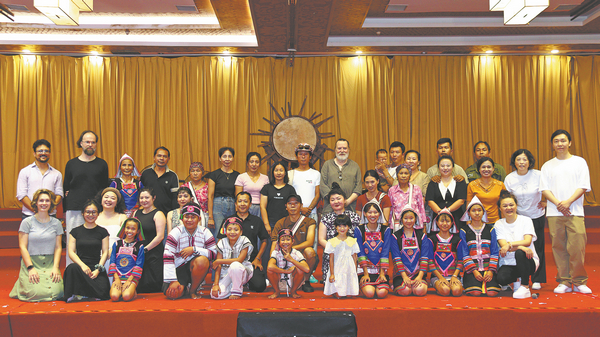RESOURCES
Updated: 2025-10-11 14:53 ( China Daily )
Folk traditions of the Jino people will be heard in Beijing and New York as a new production prepares to hit the stage, Chen Nan reports.
In the verdant hills of Xishuangbanna, Yunnan province, where the Jino ethnic group has lived in relative isolation for centuries, Du Yun's latest project, The Ocean Etched in the Forest, finds its roots. This ambitious work, which blends the ancient folk traditions of the Jino people with contemporary sound, marks a profound intersection of history, culture and modern innovation.
The world premiere of The Ocean Etched in the Forest will take place on Sunday as part of the 28th Beijing Music Festival, a prestigious event launched in 1998 and sponsored by the Beijing Municipal Bureau of Culture and Tourism. The production will then travel to the Lincoln Center for the Performing Arts in New York on Nov 7, marking a significant step in Du's mission to take the Jino people's rich cultural heritage to global audiences.

Children of the Jino ethnic group from Yunnan province rehearse for The Ocean Etched in the Forest. CHINA DAILY
Du was born and raised in Shanghai. An alumna of the Shanghai Conservatory of Music, Oberlin College and Conservatory, and Harvard University, she currently lives in New York and is a professor of composition at the Peabody Institute of the Johns Hopkins University.
For Du, this project is not merely about music — it's an exploration of identity, heritage and the power of storytelling across generations. A Pulitzer Prize-winning composer renowned for her boundary-defying creations, Du seeks to use this work to amplify voices that have long been marginalized, bringing ancient traditions into the present.
The Jino people, an ethnic group in southern China, are keepers of a unique and ancient oral tradition passed down through songs that recount the histories, emotions and myths of their people. In 1979, the Chinese government officially recognized the Jino as the country's 56th ethnic group.
Du, alongside her longtime collaborator, director and designer Julian Crouch, journeyed to Baduo village in Xishuangbanna, and spent time with local Jino elders and children to learn about their music, stories and way of life.
"I was struck by the resonance of these songs and how they spoke not only to the past, but also to the present," Du says. "The children of the village, the future bearers of this heritage, sing these ancient tunes with passion and purity."

He Guiying (right) and her granddaughter, 11-year-old Piao Yunxian, perform onstage. CHINA DAILY
Through this collaboration, Du and Crouch were inspired to create a space where the Jino people's deep connection to the land, forest and their profound ecological awareness could find new life, echoing across time and borders.
"We wanted to ensure that these ancient emotions — these deep cultural ties — would not just remain in the past but would speak to contemporary audiences," Du notes. "I don't consider myself a composer in this production because the music is already there. I bring my own concept to it and reimagine it."
One of the Jino folk songs that Du encountered during her visits to Yunnan was The Shell Song, which tells the tragic tale of forbidden love. In The Ocean Etched in the Forest, Du reimagines this song, blending it with her own compositions and melodies while staying true to its original spirit. The result is a new version of the song that bridges past and present.
Crouch, ever the innovator, brought his vision to life by crafting two large puppets from local materials to represent the tragic lovers of The Shell Song. This unique form of interactive storytelling blends the materials of the Jino people's daily lives, such as bamboo used to make baskets and mats, with modern theatrical techniques, adding a visual and dynamic layer to the performance.
Another key collaborator in The Ocean Etched in the Forest is He Guiying, 58, an inheritor of the Jino drum dance, a traditional performance of intangible cultural heritage at the national level. She will also appear in the production in both Beijing and New York, bringing her own expertise and passion for the tradition to the stage.

Jino children in rehearsal with an artist from The Ocean Etched in the Forest. CHINA DAILY
According to Jino legend, the creator goddess made a boy and a girl and placed them inside a large drum to survive a natural disaster. The two children floated on water for days before finding land. They married and gave birth to humanity. As a symbol of reverence, the Jino people hang the sacred drum in the air rather than place it on the ground. The drum dance was traditionally performed to pay tribute to the ancestors.
"The Jino people regard the large drum as a mother figure," said He in an earlier interview. "It embodies and encompasses all things in the world. The drum dance is the highest ceremony to honor the goddess, a ritual of gratitude and blessing for the land."
However, this sacred tradition came with a prohibition: women were not allowed to touch the sacred drum, nor could they participate in its preservation or the ceremonies. For He, this prohibition only fueled her curiosity. As a young girl, she would watch the men play the drum and secretly observe their technique. She longed to try it herself.
"When everyone else had gone, I would stay behind and quietly practice on the large drum," He recalls. "I wanted to express my life through the drum dance, to use new and inventive movements to reflect my own self."
Her innovative approach, which included new choreography and unique drumming techniques, was initially met with resistance but eventually earned admiration. By age 18, He began teaching the drum dance to others. Today, at 50, she is the sole national-level inheritor of this tradition and has taught the drum dance to countless students, making her one of the most prominent practitioners of the art form.
This sacred drum, which plays a central role in the Jino people's cultural rituals and is an essential element of The Ocean Etched in the Forest, will be brought to both Beijing and New York.
Among He's students is her 11-year-old granddaughter, Piao Yunxian, who will also perform in The Ocean Etched in the Forest. Another performer is 13-year-old Yan Zi, a child with a hearing impairment, who also learned the drum dance under He's tutelage.
Du's dream, besides allowing more people to appreciate the Jino culture, is to see these children — whose voices carry the weight of centuries — perform on the world's largest stages, sharing their ancestral stories with new audiences.

The creative team behind The Ocean Etched in the Forest, including Du Yun and Julian Crouch,
pose with local people of the Jino ethnic group in Yunnan. CHINA DAILY
"We took videos of these children, asking them to share their wishes," Du says. "Their answers will be screened during the performance, giving them a voice in the production.
"I asked myself what kind of impact this production could have on these children," she says. "What comes next after the performances? I want them to dare to dream and fulfill those dreams. I also want them to teach their children to sing these old folk songs and pass on the Jino drum dance to future generations."
The Ocean Etched in the Forest is a product of Du's FutureTradition initiative, which she launched in 2017. The project focuses on illuminating the roots of folk art and building cross-regional collaborations. For Du, tradition and innovation are not opposites but complementary forces.
"Cultural evolution has always been about resilience and creativity," she says. "No matter where you are, young generations share a curiosity about their roots, and through cultural exchange, new forms of art are born."
Contact the writer at chennan@chinadaily.com.cn